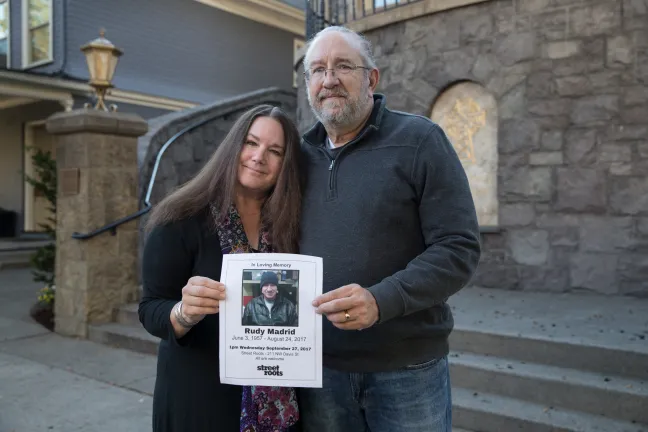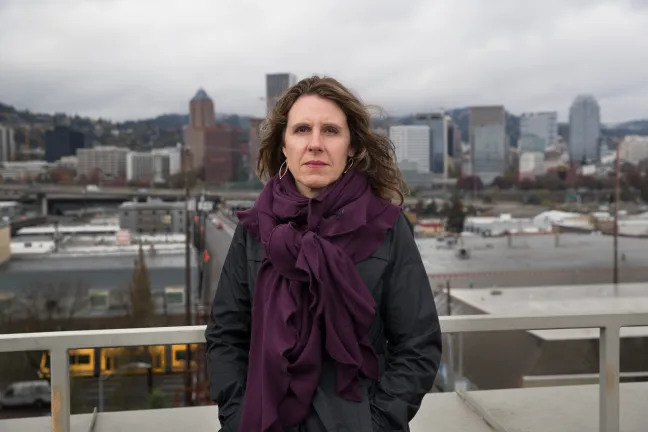A baby. A young mother. People who were black, Latino and white. Men and women of retirement age. Some from stable families and others with traumatic pasts. But none of them had a home.
During the 2017 calendar year, 79 people died in Multnomah County while experiencing homelessness, according to an analysis by a team of researchers at the Multnomah County Health Department. Those who died ranged in ages from less than one year old, to 81. [
One man died at the County’s easternmost edge in the Columbia Gorge, jumping from the Bridge of the Gods after a decades-long battle with mental illness. His family mourns him still.
Another man died on a summer night in the doorway of a downtown Portland business, after losing his battle with addiction.
A young woman died in a Portland shelter after overdosing on heroin and meth. Despite being raised by a loving family, she was haunted by a violent infancy. She could neither escape her past nor trust anyone to share her future.
“She felt like she had to be in the world all by herself,” said the woman’s mother, Catherine. “She wanted friends, but she didn’t have them. She wanted peace, but she couldn’t find it.”
“Every year, we report on homeless deaths. Every year the deaths are too many, the people are too young, and the causes too preventable. In every case a lack of housing played a role,” said Tri-County Health Officer Dr. Paul Lewis. "I know our collective public, private, non-profit, and volunteer efforts prevent many, many deaths but, I am still ashamed at the number we continue to report every year."
These findings are part of the 2017 Domicile Unknown report, a project of the Health Department in partnership with Street Roots, and sponsored by Multnomah County Chair Deborah Kafoury. The project began in 2012 as way to drive policy and funding decisions on housing, health and homelessness. The first report examined the cause of death of 47 men and women who died on the streets in 2011. Since then, at least 391 more residents experiencing homelessness have died in Multnomah County.
The number of those who died so far in 2018 is comparable to the number who died in 2017. At least 49 people who were experiencing homelessness died in Multnomah County between Jan. 1, 2018 and Oct. 8, 2018 according to an interim review of Medical Examiner data, Dr. Lewis reported. The cause of death, manner and location will be analyzed and become part of the 2018 report.
More than half of those who died while homeless in 2017 passed during the cooler months, October through March. Five people died of hypothermia during the month of January.
About 20 percent of people died in a hospital bed, and nearly that many died in a shelter bed, motel or someone else’s home. About 60 percent of people died outside — in or near tents, or in cars, RVs or campers.
“Every single person we’ve lost is a member of our community who once had a family and a future,’’ said Chair Deborah Kafoury. “We mourn them. We try to learn lessons from their loss. But we honor them by doing everything we can to end this manmade crisis.”
Statewide, the leading causes of death are cancer and heart disease. But for those experiencing homelessness in Multnomah County, the leading causes of death are drugs and alcohol — themselves so often symptoms of underlying emotional trauma or mental illness.
“When you’re a drug addict, death is always going on. People are always dying,” said Art Garcia, a longtime Street Roots volunteer. “It was really often that people overdosed and you’d wake up and someone would be dead. You’re talking to the guy, and the next morning you wake up and they’re gone. On the streets, it’s like that, every day.”
Drugs or alcohol played a role in the deaths of 46 people. Among those, methamphetamine was noted in 21 individuals, about 46 percent. That’s a jump from previous years’ meth-related deaths, which accounted for 30 percent of drug-related deaths among those experiencing homelessness.
Opioids — mostly heroin — were noted in 19 individuals, about 41 percent. An additional 10 people were found to have died from a combination of opiates and meth.
“Meth is one of those things that just never went away,” said Lt. Art Nakamura with the Portland Police Bureau’s Drugs and Vice Division. Back in 2000, when meth was often produced locally, police would seize a pound of meth that was 50 percent pure, worth $15,000. Today, that same pound, produced in Mexico, is 90 percent pure and one-fifth the cost.
“Part of being on the street, you just want to get away from reality of the suffering when you have nowhere to live,” Nakamura said.
Health Officer Lewis said housing is the first step to recovery.
“We’re not going to prevent these deaths until we treat the substance use disorder. And we’re not going to treat the substance use disorder while people are living under a bridge.”
Street Roots Executive Director Kaia Sand said we have a responsibility to see hope in the hardship.
“That's our daily work, isn't it?,” she said. “Every day is both heartbreaking and triumphant at Street Roots.”
People in failing health come to the newspaper, people who could, too easily, end up in a report like Domicile Unknown. But Sand also sees lives change. People put themselves back into housing, they get sober, they adopt a dog — or a rabbit. They plan a bus trip to see the ocean. They find community.
“When we think about the people dying, it's easy to shut down,” Sand said. “My hope is that we don't shut down to each other's humanity. That we step up for each other. It's my hope that with disturbing, powerful information, we turn toward each other.”


